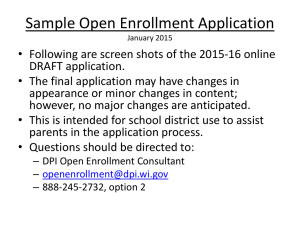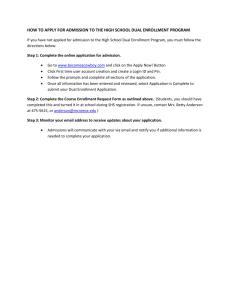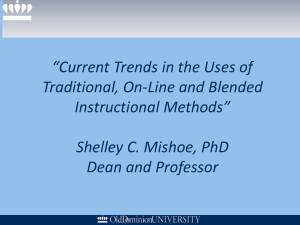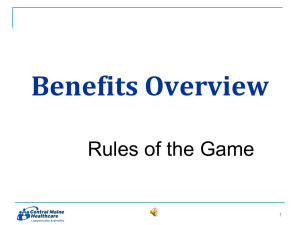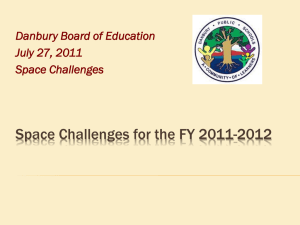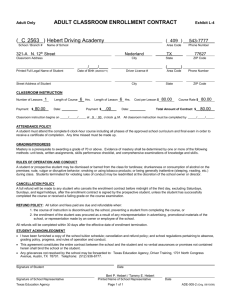Executive Summary EM Plan - University of Wisconsin
advertisement
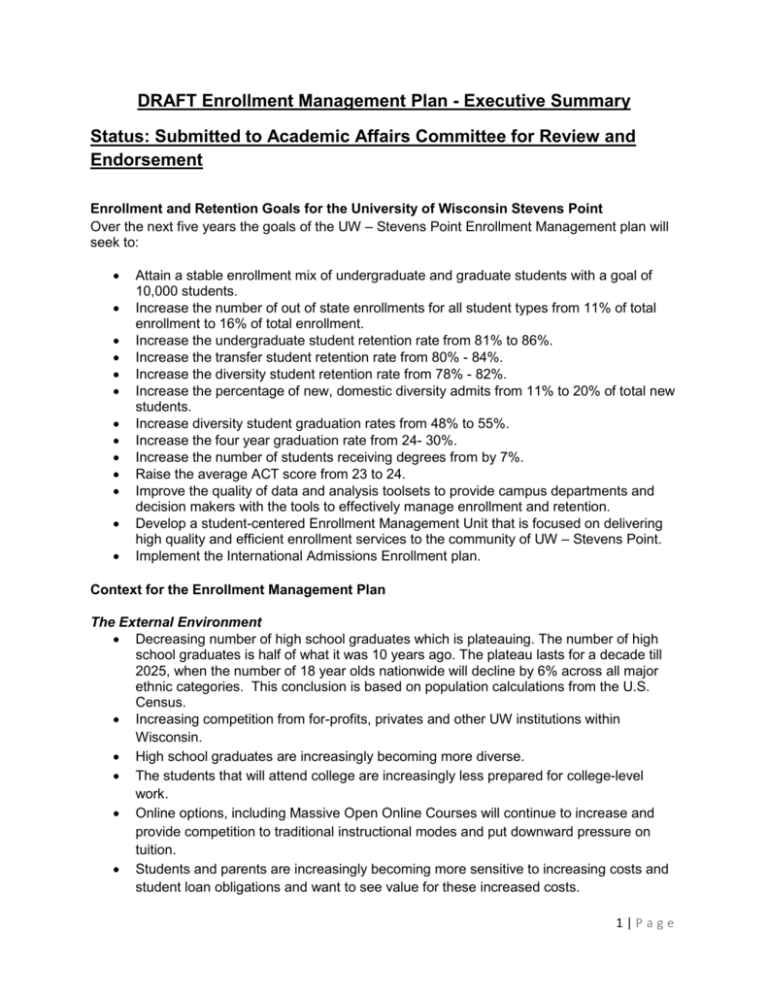
DRAFT Enrollment Management Plan - Executive Summary Status: Submitted to Academic Affairs Committee for Review and Endorsement Enrollment and Retention Goals for the University of Wisconsin Stevens Point Over the next five years the goals of the UW – Stevens Point Enrollment Management plan will seek to: Attain a stable enrollment mix of undergraduate and graduate students with a goal of 10,000 students. Increase the number of out of state enrollments for all student types from 11% of total enrollment to 16% of total enrollment. Increase the undergraduate student retention rate from 81% to 86%. Increase the transfer student retention rate from 80% - 84%. Increase the diversity student retention rate from 78% - 82%. Increase the percentage of new, domestic diversity admits from 11% to 20% of total new students. Increase diversity student graduation rates from 48% to 55%. Increase the four year graduation rate from 24- 30%. Increase the number of students receiving degrees from by 7%. Raise the average ACT score from 23 to 24. Improve the quality of data and analysis toolsets to provide campus departments and decision makers with the tools to effectively manage enrollment and retention. Develop a student-centered Enrollment Management Unit that is focused on delivering high quality and efficient enrollment services to the community of UW – Stevens Point. Implement the International Admissions Enrollment plan. Context for the Enrollment Management Plan The External Environment Decreasing number of high school graduates which is plateauing. The number of high school graduates is half of what it was 10 years ago. The plateau lasts for a decade till 2025, when the number of 18 year olds nationwide will decline by 6% across all major ethnic categories. This conclusion is based on population calculations from the U.S. Census. Increasing competition from for-profits, privates and other UW institutions within Wisconsin. High school graduates are increasingly becoming more diverse. The students that will attend college are increasingly less prepared for college-level work. Online options, including Massive Open Online Courses will continue to increase and provide competition to traditional instructional modes and put downward pressure on tuition. Students and parents are increasingly becoming more sensitive to increasing costs and student loan obligations and want to see value for these increased costs. 1|Page The U.S. Department of Education is developing a quality ranking and rating system for higher education that will determine institutional financial aid awards. Growing demand from employers for workforce readiness skills. The Internal Environment University Strengths o Unique programs which are popular with students. o High rate of success for graduates in further higher education and employment. (link to employment data) o High visibility and strong brand recognition within Wisconsin, especially within the North Central Wisconsin region. o New Strategic Plan o Inclusive shared governance o Strong sense of institutional mission within faculty and staff o Caring and supportive environment for students. o Implementation of new General Education Program requirements. o Implementation of MAP-Works software. o Low default rate for student loans. o Average student debt is $23,000 and is similar to comparable institutions. University Challenges o Enrollment imbalances in major programs o Class scheduling conflicts for students and facilities o Under-utilization of facilities resulting in decreasing state funding for improvements to instructional space and an inefficient use of resources. o Scholarships are largely given to upper classmen rather than being used to attract new freshman. o There is no campus-wide coordination of college/department scholarships. o Retention and graduation of diversity students is lower than overall student retention. o University retention activities while demonstrating effectiveness, lack a coordinated approach. o Online services are not comparable to our competitors. o Inability to automate registration functions hampers faculty and staff productivity. o Lack of an ability to be able to perform analytic and predictive capabilities with student data creates a competitive disadvantage. o Current student information system requires significant enhancements to provide for requisite checking, historical dated rows to measure student enrollment changes, enrollment apportioning within sections, and automation of enrollment restrictions. o Manual processes throughout the university that increases the error rate and lowers staff productivity thereby negatively impacting data quality. o Lack of eform/business process management system slows the timeliness of forms processing. 2|Page o o Lack of a Constituent Relationship Management system to develop prospective students in order to increase the applicant pool. (Implemented CRM last year) Lack of a student advisement and comments system to ensure effective academic planning and advisor/student interaction. Institutional Enrollment Strategies Develop a reporting system to forecast course demand and utilize that to maximize enrollments and capacity planning. Increase funding for freshman, diversity and out of state scholarships. Systematize the Project Win-Win concept of awarding associate degrees for students who withdraw or leave prior to completing bachelor degree. Implement the International Student Recruitment Plan. Review options for 2+2 enrollment agreements with international institutions. Develop and implement an annual recruitment plan for the Admissions Office. Develop consistent and comprehensive branded recruiting materials. Develop programs that can be completed online or in the evening/weekend timeframe for adult learners. Review program capacities and if majors are designated to grow, review their departmental staffing and fiscal capabilities to do so. Review registration and academic policies to ensure that they enhance student retention and comply with appropriate state and federal regulations. Retention Strategies Develop a campus-wide retention plan. Implement MAP-Works or its equivalent for all student types. Implement a pre/co-requisite checking system to ensure adequate course preparation prior to enrollment in a class. Implement an enrollment system that allows for the automated apportioning of high demand classes to minimize course bottlenecks. Implement the use of provisional admissions for majors with a retention problem. Implement a conditional admission process for students who are admissible, but who may need to remediate specific academic challenges. Review current campus retention strategies to determine effectiveness and how to maximize benefits from these efforts Develop on-campus support services for out of state students, international students and adult learners. Enrollment Management Unit Strategies Review Registration and Records staffing to develop a staffing model based on future office needs. Evaluate, plan and implement a “one-stop” enrollment services model. Integrate departmental functions wherever possible to improve efficiencies and services. Review and revise the new and transfer student orientation processes. Develop an online registration process for new students and transfer students. Review current operations to ensure compliance with the Department of Education regulations. 3|Page Develop an organizational structure that emphasizes cross-training and cross support functions within Enrollment Management departments. Coordinate and enhance unit communications to ensure effective student recruitment and excellent service to students, faculty and staff. Align recruiter responsibilities with dedicated territories in order to focus efforts on the most productive regions and to provide prospective students with the best possible service. Enrollment Management Technology Strategies Review the Student Information System to determine the best option for the upgrade of the existing system either through additional build out or SIS replacement with an ERP. Implement digital imaging across all Enrollment Management offices to reduce operational costs and improve the quality and speed of services. Convert all existing student records to a digital storage format. Implement digital forms/business process management software across all departments within Enrollment Management. Implement a service desk tool to provide 24/7 student access to FAQ’s and troubleshooting routing. Purchase and implement software that will provide departments and colleges with an efficient method to process scholarship applications and a tool that will provide students with an easy way to find and apply for scholarships on campus. Implement constituent relationship management software to increase the applicant pool, to develop enrollment targets by major and track recruitment activities to determine effectiveness. Upgrade existing degree audit system to incorporate interactive degree audit, what if and student planner capabilities. Purchase and implement a business analytics solution. Data and Analytics Plan – Measuring Effectiveness Develop data definitions and metrics to ensure consistent measure of enrollment and retention goals. Develop enrollment targets by program within CRM system to measure recruitment productivity. Develop effectiveness measures for each unit within Enrollment Management and provide feedback reporting to ensure that enrollment goals are met. Develop effectiveness measures for retention programs across the campus to ensure that enrollment goals are met. Develop predictive and analytical business intelligence capabilities to project enrollment and retention for the University. Develop institutional enrollment and retention production reporting that is utilized effectively by academic departments for planning, advising and evaluation. 4|Page
